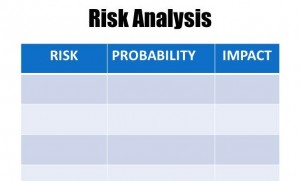More words to know!
The more you read about Disaster Recovery and Emergency Preparedness, the more abbreviations and acronyms you come across. Many of them are already in use in business – like KISS , or Keep It Simple Stupid. But as in every industry, some words creep in that are not explained, and that you are simply expected to know. If you don’t know them, you feel stupid or confused or both.
Here are some of the common words I’ve come across in dealing with preparedness in the workplace. (It’s a companion piece to our earlier list of emergency preparedness vocabulary.)
This is by no means a complete list, but it’s a good start for talking with or or writing to industry professionals!

Simple tool for assessing risks facing the business
Business Acronyms and Definitions
BAU – Business As Usual. If this is the state you want to return to AFTER the emergency, then it’s considered something positive. However, BAU is often used when projecting what the future will be like if we go on with BAU instead of making suggested changes.
BIA – Business Impact Analysis. One step in the process of building an Emergency Preparedness Plan. It describes and measures what would happen to the different business functions in the event of an accident, disaster or emergency. The analysis covers both financial impacts as well as non-financial impacts, such as loss of customer or supplier confidence, etc.
BP — Best Practices. Methods or techniques that have shown the best results over time and around the country (or world) and that have become the standard for the industry.
CBCP – Certified Business Continuity Professional. This is the most well-known certification in the industry. It is offered by DRI International (Originally the Disaster Recovery Institute). The certification requires more than two years of experience, with proven expertise in five different subject areas, and requires continuing education.
DR/BC — Disaster Recovery/Business Continuation. These two expressions are often used together, but DR seems more closely tied to the protection and restoration of data and information technology systems, whereas BC refers to the whole business.
KISS — Keep It Simple Stupid. A classic reminder for educators, salespeople and for those who design Emergency Plans!
RA – Risk Analysis. Risk analysis is one of the first steps to building an Emergency Plan. Risks are identified and rated by likelihood and by likely impact, often using a matrix showing frequency/importance.
RM – Risk Management. This is closely tied to Risk Analysis, and typically covers actions the organization can take to prevent or lessen the risks identified in the analysis.
SME – Subject Matter Expert. You? Your local Fire Chief? Head of a department? Facilities manager? Whoever knows the most about the topic/risk/equipment/impact under discussion!
SOW – Statement of Work. If your organization decides to hire a consultant to help in developing your Emergency Plan, you’ll likely ask for, or actually provide yourself as part of the consulting contract, a statement of work that outlines exactly what is to be done by the contractor.
Action Item: This is a list that can easily be shared with co-workers or with your boss. It will give everyone a sense of confidence in dealing with Emergency Preparedness, particularly if it is a new subject.
Virginia
Your Emergency Plan Guide Team
Don't miss a single Advisory.
Thank you for subscribing.
Something went wrong.
